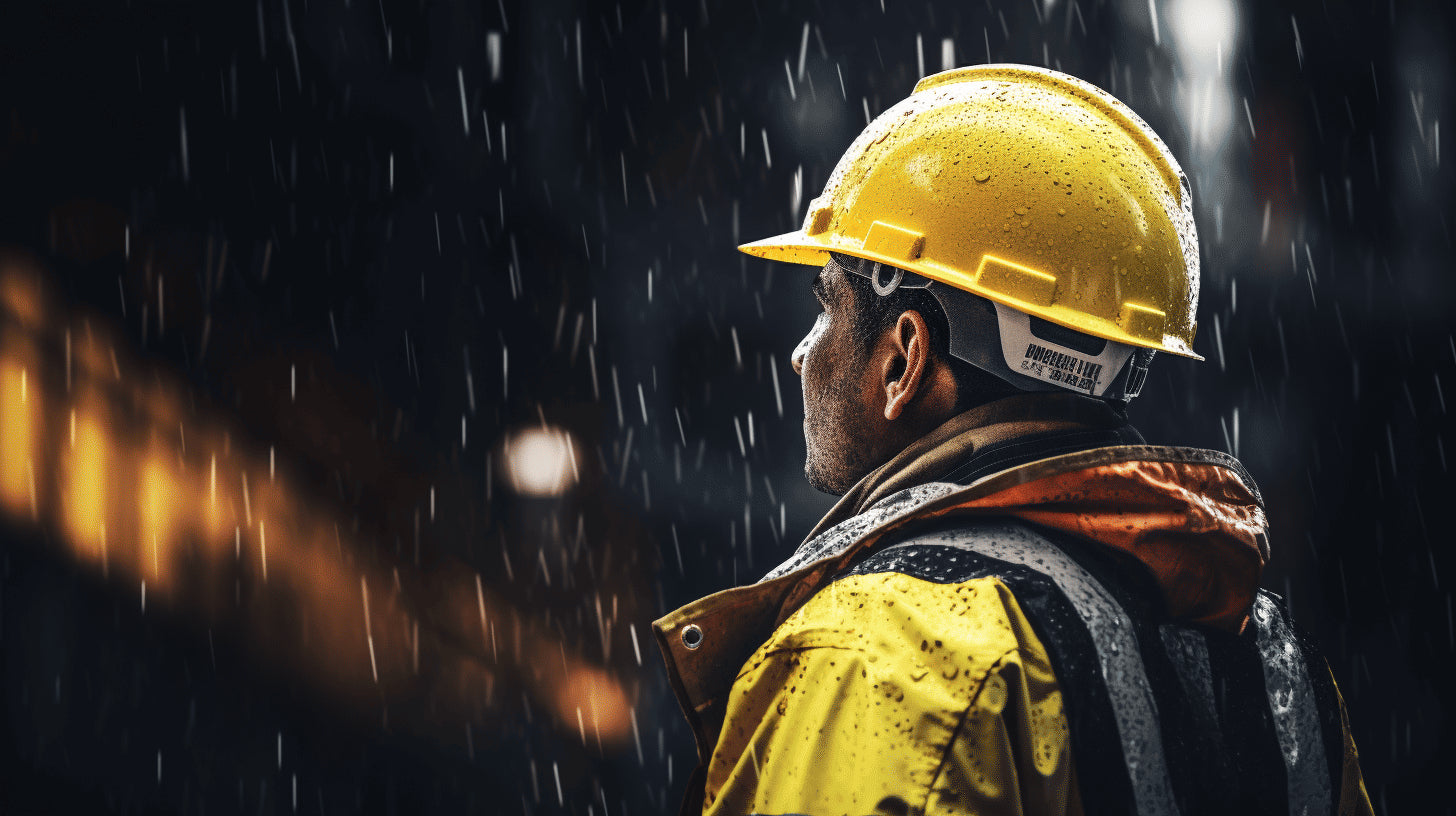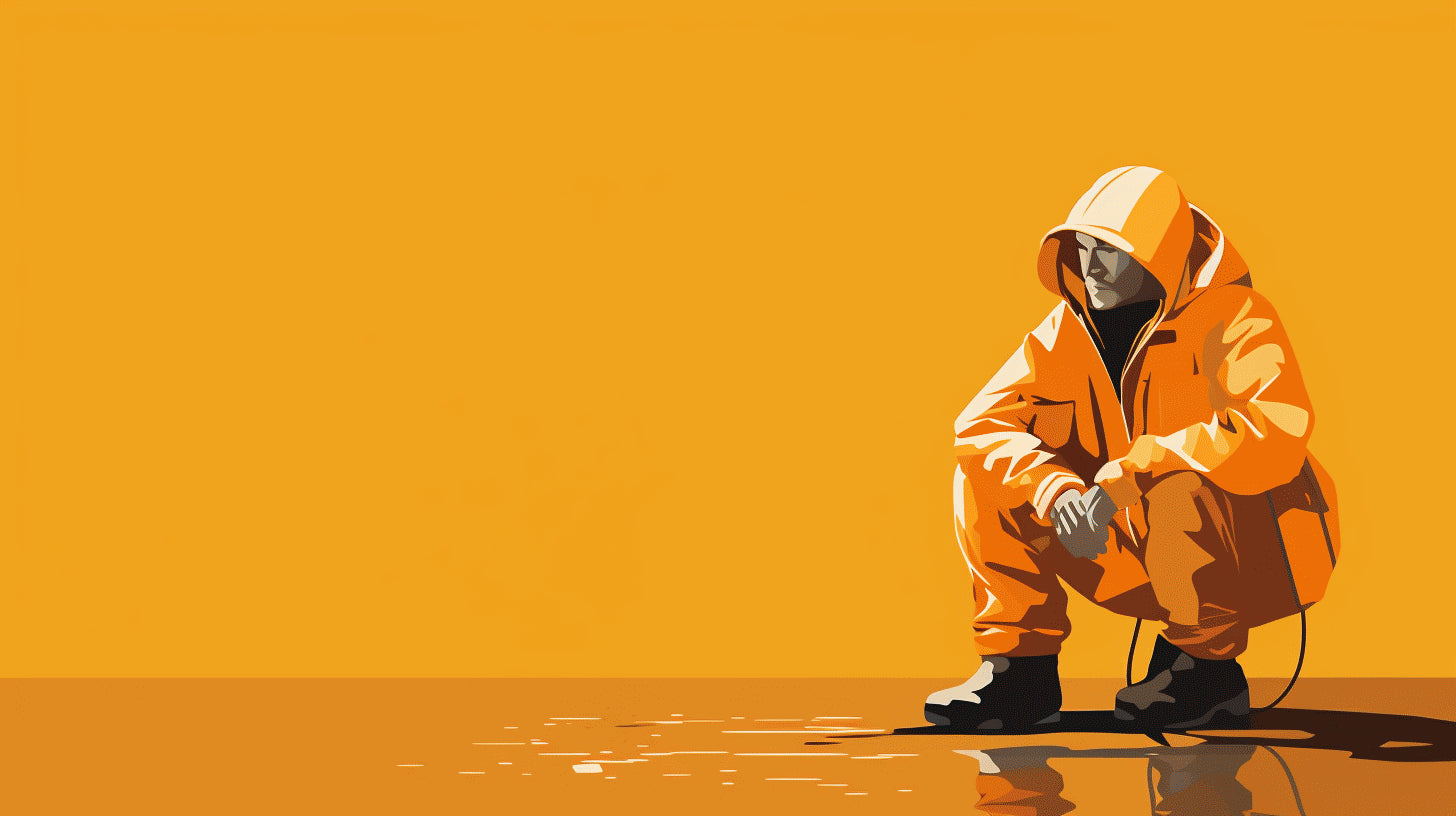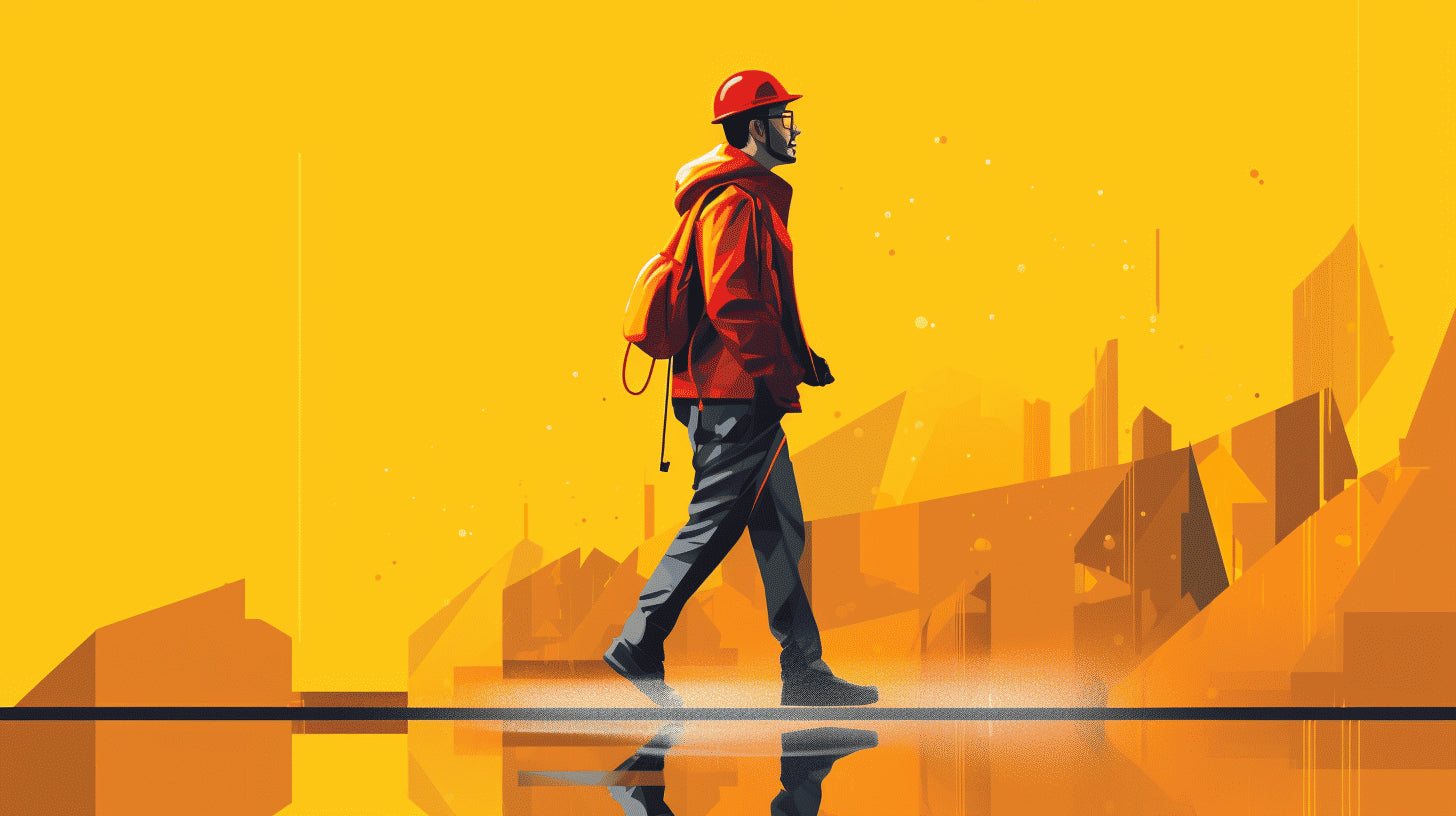Stepping outside on a rainy day can be a tricky affair, even for those strolling leisurely under an umbrella. Now, imagine being a construction worker on a jobsite, braving heavy rainfall while carrying out complex tasks. A construction worker without adequate rain gear can encounter issues with visibility, performance, and safety. Not to mention, the discomfort and health risks that can come from prolonged exposure to wet and cold conditions.
The importance of proper rain gear for construction workers, therefore, cannot be overstated. From ensuring productivity to enhancing safety, high-quality rain gear is an investment that yields plentiful benefits with every downpour. This guide will navigate you through the importance of rain gear, essential factors to consider when buying, tips for selecting durable gear, types of rain gear, and how to maintain your gear for longevity. By the end, you'll almost look forward to those rainy workdays!
Whether you're new to the construction industry, seeking to upgrade your current rain gear, or just looking to understand more about this essential protective wear, this guide has got you covered.
The Importance of Rain Gear for Construction Workers
As the popular adage goes, "the show must go on." This phrase forms the cornerstone of many industries, but none exemplify it quite like construction. Regardless of the forecast, construction workers must be prepared to face the elements, rain or sunshine, with unyielding determination. But coping with weather conditions isn't merely about mental fortitude; it primarily hinges on having the right protective gear. The significance of rain gear for construction workers cannot be overstated, as it greatly influences safety, comfort, and productivity.
Safety Matters
Firstly, rain gear serves as a lifeline for construction workers, safeguarding them from the perils associated with wet conditions. Heavy rain can increase the likelihood of slips, falls, and other accidents. Here's where rain gear comes into play:
- Waterproof Boots: These provide necessary traction, reducing the risk of slips and falls on slick surfaces.
- High-Visibility Jackets: Rain can lead to poor visibility; high-visibility jackets ensure workers can be seen clearly by others.
- Rain Hats or Helmets: Besides keeping the head dry, these can prevent rain from obscuring vision, reducing the chance of mishaps.
Worker Comfortability
Rain gear does more than just protect workers from accidents, it also ensures they stay comfortable. Unending drizzles or sudden downpours can lead to discomfort, impacting a worker physically and mentally. This makes it challenging to maintain concentration, leading to decreased quality and efficiency. Rain gear can alleviate these troubles since high-quality pieces are:
- Rain-resistant: Keeps workers dry, making it easier to maintain focus.
- Breathable: Prevents overheating by allowing moisture to escape, ensuring workers don't get too sweaty.
- Flexible: Allows freedom of movement, making it easy to carry out tasks.
Productivity Enhancement
Every employer aspires to have a productive workforce, and providing suitable rain gear is a solid step in that direction. Apart from protecting workers and keeping them comfortable, rain gear can also enhance productivity by:
- Preventing sick days: Constant exposure to rain can make workers prone to colds and other illnesses. Rain gear shields against this, leading to fewer sick days.
- Increasing morale: Providing quality rain gear shows a company's commitment to worker safety and well-being, boosting morale and motivation.
- Reducing delays: By allowing work to continue seamlessly despite rainfall, rain gear prevents project delays.
In the grand scheme of things, the importance of rain gear for construction workers is undeniable. It's a crucial tool that protects workers, makes them comfortable, and bolsters productivity. While it's an investment, it's one that pays off manifold, fostering a resilient workforce that can march on – come rain or shine.
Remember, when it comes to rain gear, quality matters. Cheap, ill-fitting gear won't offer the same protection or comfort and can lead to accidents or decreased productivity. It's imperative to invest in well-made, functional gear that caters to the needs of each worker. A happy, safe, and productive worker is an asset to any construction project.
Factors to Consider When Buying Rain Gear
While preparing for an epic outdoor adventure or simply bracing for sudden showers in everyday life, one gear that can make a huge difference is top-notch rain gear. But not all rain gear is created equal. Selecting the ideal ensemble isn't merely about picking the one that promises to keep you dry. There's more to it! Here are five critical factors you should consider when scouring the market for rain gear.
Ensure Waterproofing
Waterproofing should top your priority list. It's the primary function of any rain gear after all. But how can you ascertain the effectiveness of this feature? Check to see if the gear utilizes a waterproof membrane. This high-tech fabric layer is responsible for repelling water molecules while allowing vapor to escape, keeping you both dry and sweat-free. Brands with well-established waterproof technology include GORE-TEX and eVent.
Breathability Check
Yes, your rain gear needs to keep you dry from the external elements, but what about internal moisture from perspiration? This is where breathability comes in. Breathability is about getting that desirable balance of being waterproof and vapor permeable. Generally, gear with in-built venting options like underarm zips or back vents offer good breathability, effectively wicking away internal moisture.
Material Durability
Rain gear is an investment. It needs to withstand the test of time and rough use. Well-constructed rain gear uses sturdy, tear-resistant materials that can handle anything Mother Nature throws at it. Beyond just marketing claims, it's crucial to check for reinforced areas especially at the shoulders, elbows, and knees - common areas of contact and friction. Also, abrasion-resistant fabrics and double-stitched seams can significantly boost the life of your rain gear.
Weight and Comfort
Always keep in mind that prolonged use can make your rain gear feel heavy. This is why weight and comfort matter. Lightweight materials that offer high resistance to rain, wind, and endure rough weather conditions without tearing are top choices. Ideally, rain gear should be easily packable and not take up much space in your backpack or duffel bag.
Rain Gear Size and Fit
Last but not least, finding the right size and fit is non-negotiable. Brands may vary in their sizing charts. Hence, familiarizing yourself with specific brand sizing can be beneficial while buying online. An ideal rain gear fit is comfortable yet snug, with potential layering space for colder weather. Baggy rain gear does little good against the wind. Similarly, gear too tight restricts movement and adds discomfort.
Keeping these factors in mind will make you well-prepared to find rain gear that perfectly suits your needs. Whether you're an avid hiker, a seasonal camper, or someone looking to stay dry during city showers, the right rain gear can make all the difference, providing not only protection but also ensuring exceptional comfort and longevity. So next time when those rain clouds gather, you'll be ready!
Tips for Selecting Durable Rain Gear
If you've ever ended up soaked through after donning supposedly 'waterproof' gear, you know the importance of investing in truly durable rain gear. Staying dry in any weather depends substantially on the quality and characteristics of the gear you choose. Here are a few reliable tips that could help you pick the best rain gear capable of withstanding even the harshest downpour.
Opt for Reinforced Seams
Reinforced seams are critical in any durable rain gear. They add to the strength of the apparel, making it resistant to tear and wear. Furthermore, their construction helps minimize areas through which water can seep in, ensuring that you stay dry.
Check for Quality Waterproof Material
Quality waterproof material differentiates aesthetically pleasing but impractical rain gear from those that can keep you dry when it matters. Breathable fabrics like Gore-tex, Tyvek, and eVent repel water on the outside and wick away moisture on the inside, keeping you comfortable. When shopping, maintain a keen eye for such fabrics.
Consider Gear with Ventilation Features
Often overlooked, ventilation features like pit zips and mesh panels can significantly elevate your rain gear. They allow air to circulate, preventing overheating and the resultant uncomfortable sweaty feeling that comes from wearing low-quality rain gear.
Choose Full Coverage Gear
Full coverage gear is much more effective in keeping you dry. Opt for raincoats that extend past your waist and rain pants that reach your ankles. Remember, the goal is to stay dry, not just to look stylish in the rain!
Check for Double Stitching
Double stitching adds two rows of stitches, strengthening the seams and increasing the durability of the rain gear. In addition to improved durability, double-stitched seams offer enhanced water resistance, ensuring your dry comfort.
Importance of Reflective Material
While not directly related to the gear's durability, reflective materials on rain gear can increase your safety in low light conditions. This is particularly important if you will be out and about in stormy weather or during dusk and dawn when visibility is diminished.
Choosing the right rain gear means considering durability and functionality along with comfort. Remember these tips the next time you're in the market for rain gear, and enjoy staying dry no matter what the weather brings!
Types of Rain Gear for Construction Workers
While weather conditions can sometimes be unpredictable, it's critical for construction workers to be well-equipped to handle any situation. Heavy rain, in particular, can quickly transform a construction site into a wet and slippery havoc. But with the right rain gear, these workers can continue to operate in comfort and safety, ensuring project timelines are met under any weather condition. Let's dive into the varieties of rain gear most suitable for construction workers.
Rain Jackets
Rain jackets are the first line of defense against heavy shower. They shield the upper body from moisture, helping the worker stay dry and focused. The designs may vary, but the best rain jackets for construction work typically include the following features:
- Waterproof material to prevent water seepage
- Breathability for comfort during long hours of work
- High-visibility colors and reflective tapes for on-site safety
- Durable fabrication to withstand rough outdoor conditions
Pro tip: While loose rain jackets offer breathability, they should also fit snugly to avoid getting caught in machinery.
Rain Pants
Just like rain jackets, a pair of sturdy rain pants is key to staying dry and comfortable from the waist down. Similar to rain jackets, these pants should be made out of waterproof material and offer breathability. However, rain pants designed for construction workers often have additional requirements like:
- Reinforced knees for added durability
- Adjustable waistbands and leg openings for a perfect fit
- Slip-resistant features to maintain safety in slippery conditions
Remember, it's essential that rain pants are paired with appropriate footwear to make the outfit waterproof from head to toe.
Rain Boots
Speaking of footwear, rain boots are the unsung heroes of a construction worker's gear. They keep their feet dry and provide much-needed traction on wet terrain. Consider these elements when selecting rain boots:
- Water-tight construction
- Skid-resistant soles for better grip
- Steel-toe protection to stay safe from heavy objects
- Comfortable fit for long work shifts
Consider also, there are solutions available to make your current footwear water-resistant, such as slip-on covers.
Rain Suits
For comprehensive protection, many professionals opt for rain suits. One piece of clothing can essentially cover the worker from head to toe. Rain suits combine the benefits of rain jackets, pants and sometimes, even boots. Noteworthy benefits include:
- Complete body coverage: Unlike separates, rain suits won't let water get in at the waist or any other junctures.
- Better value: Buying a full suit often turns out to be cheaper than purchasing individual pieces.
- Convenience: Putting on and taking off a rain suit is quicker, saving precious work time.
Now that you're armed with this information about rain gear, you're ready to keep safe and dry, no matter the weather at your construction site. Remember - staying dry isn't just about comfort, it's about safety. Invest in quality gear that will serve you well.
Maintaining Your Rain Gear for Longevity
The rain gear you’ve invested in is only as good as the maintenance it receives. Regular and meticulous care can ensure your rain gear’s optimal performance and longevity, so it stands up against the fiercest storms. From cleaning and storage to inspections and waterproof coating reapplications, we've got you covered. Let's delve into how to keep your rain gear in stellar shape.
Proper Cleaning
Ideally, your rain gear should be cleaned after each use. Dirt and grime can break down the material, affecting its ability to keep you dry.
- Detergents: It's crucial to use gentle, gear-friendly detergents. Harsh chemicals can erode the waterproof coating of your gear.
- Wash cycle: Always use a gentle wash cycle when cleaning your rain gear. If your washing machine has a specific setting for waterproof items, even better!
- Drying: Instead of throwing your gear in the dryer—which can damage the material—allow it to air dry. If drying outside, avoid direct sunlight, which can cause fading.
Remember, the delicate fabric's integrity depends substantially on how it's cleaned.
Appropriate Storage
The way you store your rain gear when it's not in use also contributes significantly to its longevity.
- Dry your gear thoroughly: Before storing, make sure that your gear is dry. Storing gear while it's still damp encourages mold growth and could lead to an unpleasant odor.
- Store in a cool, dry place: Heat and humidity could lead to the degradation of the material. Find a cool and dry place in your home for your gear.
- Avoid Folding: Rather than folding your gear (which can cause creasing and damage the fabric), loosely roll or hang them up.
With proper storage practices, your rain gear will be ready for use whenever needed.
Regular Inspection
It's a good practice to inspect your rain gear regularly for any signs of wear and tear. Find a bright spot and hold your rain gear up to the light. If you see any light through what are supposed to be waterproof areas, you'll need to treat the material.
This proactive approach can save your rain gear from bigger problems down the road, maintaining its functionality for years to come.
Reapplying Waterproof Coating as Necessary
Waterproof coating isn't permanent and needs to be reapplied from time to time to maintain its effectiveness. There is a wide variety of products available on the market. Most waterproof reapplications are sprayed or painted onto the material, then left to dry.
The frequency of reapplication will depend on how often your gear is in use. Heavy usage might require more frequent coating reapplication.
Maintaining your rain gear requires a certain level of commitment and understanding, but the payoff is well worth the effort: gear that stays functional, good-looking, and durable throughout countless rainy seasons. Whether it's a downpour, a drizzle, or a squall, you'll be able to face the elements with confidence, knowing your gear is up to the task.
Conclusion
When it comes to construction work, rain gear is more than just a convenience item; it's a valuable tool that can contribute significantly to worker safety, comfort, and productivity. Choosing the right gear isn't always straightforward, but giving careful consideration to aspects such as waterproofing, breathability, material durability, overall weight and comfort, and size and fit can lead to more satisfied workers and more effective jobsites.
As you embark on your journey to find the perfect rain gear, remember that every detail matters, from reinforced seams and quality waterproof material to ventilation features and full coverage. Don't forget the significance of reflective material for added safety.
Once you have your rain gear, proper maintenance is essential to ensure its longevity. Regular cleaning, proper storage, and periodic inspections can help, while reapplying the waterproof coating as necessary can keep your gear performing at an optimal level.
Interested in top-notch rain gear that ticks all these boxes? Check out the high-quality, durable rain gear options at Hurricane Raingear. Made with care in the Pacific North West, our products offer the perfect balance of dryness, comfort, protection, and visibility that today's construction workers need. Don't just stay dry—stay safe and comfortable with Hurricane Raingear.
Frequently Asked Questions
-
What are the most durable rain gear materials for construction workers?
The most durable rain gear materials for construction workers are PVC-coated fabrics, nylon with PU coating, and Gore-Tex.
-
What features should I look for in rain gear for construction work?
When buying rain gear for construction work, look for features like waterproof and windproof materials, reinforced seams, adjustable cuffs and hems, reflective elements for visibility, and multiple pockets for tool storage.
-
Is it important to choose the right size of rain gear for construction workers?
Yes, choosing the right size of rain gear is crucial for comfort and functionality. Ill-fitting rain gear can restrict movement, cause discomfort, and hinder the worker's performance. Refer to the manufacturer's size chart and consider layering options when selecting the size.
-
How do I properly care for and maintain my rain gear?
To ensure the durability of your rain gear, follow the manufacturer's care instructions. Generally, it involves machine washing with mild detergent, avoiding fabric softeners, tumble drying on low or air drying, and occasionally reapplying DWR (Durable Water Repellent) treatment.
-
Can rain gear be used even in non-rainy conditions?
Yes, rain gear can be used in non-rainy conditions as well. It provides protection against wind, dust, and other environmental factors, making it a versatile option for construction workers working in different conditions. However, ensure breathability and ventilation to prevent excessive sweating.























Leave a comment
This site is protected by hCaptcha and the hCaptcha Privacy Policy and Terms of Service apply.